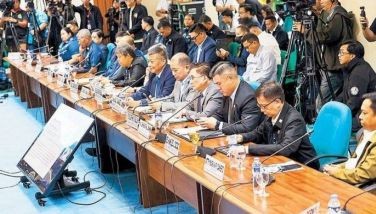Zero Hunger

Every Oct. 16, World Food Day celebrates the creation of the United Nations’ (UN) Food and Agriculture Organization (FAO). FAO is a UN specialized agency leading international efforts to combat hunger, enhance nutrition, promote sustainable agriculture, and ensure food security. This year’s theme captures the spirit of FAO’s mission – “right to foods for a better life and a better future.”
Food and nutrition security builds a better life for Filipinos. It’s a force multiplier. Investments in food security and nutrition pays exceptional dividends, from the short-term to the long-term, in terms of public health, wealth creation, and overall human development and well-being.
World Food Day aligns with the UN Sustainable Development Goals (SDGs), including SDG No. 2 of ending hunger by 2030. What’s so great about this goal is that it’s not some impossible dream; it’s achievable. In fact, the world economy produces so much food now that the amount is more than enough for the entire human population and for a surplus that could feed another billion people. Questions abound of course. Why do people still suffer from hunger?
Reasons are plenty. Global supply chains are still recovering from the drastic disruptions and many restructurings brought about by the COVID-19 pandemic. Climate change has severely altered weather patterns, wiping out whole harvests through unprecedented conflagrations, droughts, and deluges. There’s also the interminable cat-and-mouse game among government policies, private sector profit prioritization, and criminal cartels culminating in Filipinos having less healthy food to eat, if at all.
Let’s recall that from 2020 to 2022, UN figures exposed that the Philippines had the: highest number of moderate to severe food insecure people in Southeast Asia (at approximately 51 million Filipinos or almost half our entire population, and far from the regional average); the second highest number of undernourished in Southeast Asia (estimated at 6.9 million Filipinos); and among the worst rates of stunting in children. Our only recently cooled inflation, moreover, has long been vulnerable to upward pressures on food product prices, specifically with rice and with food inflation reaching a peak of 10.8 percent in January 2023, and fundamentals indicate that our food production situation and import reliant market remains highly susceptible to supply shocks and other global economic headwinds.
Not everything is bleak with the figures; in the data, there is light. The World Bank recently revised its economic growth outlook for the Philippines with a positive projection from 5.5 percent to 6 percent in 2024, and 5.9 percent and 6.1 percent in 2025. We are projected to become the second fastest growing economy in our region. Undernourishment in the Philippine population has diminished from 14.6 percent in 2004 to 5.9 percent in 2023. The lowering of our rice tariff has also eased pressure leading to lower inflation and not-so-exorbitantly-priced rice.
For a brighter tomorrow in food and nutrition security, one best practice is targeted service delivery. Stunting and wasting of children due to undernutrition and malnutrition are among the most deleterious lifetime consequences of food insecurity. Stunting, for instance, affects one out of every five children in the Philippines. Poor nutrition early in life is associated with poor economic mobility. UNICEF estimates that undernutrition costs the Philippine economy US$4.4 billion annually (equivalent to around 1.5 percent of GDP or P250.49 billion).
Senator Grace Poe spearheaded evidenced-based institutional interventions in this regard. Under the “Kalusugan at Nutrisyon ng Mag-Nanay Act” or the “First 1,000 Days Law” (Republic Act No. 11148, a landmark law that she authored, and credited to have contributed to the Philippines’ advancements in SDG targets), the government supports the first one thousand (1,000) days of a child’s life, or up to a child’s second (2nd) birthday. The UN International Children’s Emergency Fund (UNICEF) identifies said period as one of the most vulnerable and crucial developmental periods of a human being. Data suggests that every peso (P1) spent for child nutrition results in twelve pesos (P12) saved in health expenditures. Through Masustansyang Pagkain Para Sa Batang Pilipino Act of 2018 (RA 11037), which our Senate office co-authored, we established the country’s national feeding program for “undernutrition and nutrient-deficiency among children aged three years up to grade six level.” UN Educational, Scientific and Cultural Organization’s (UNESCO) studies state that enhancing learners’ health is a transformative way to improve education outcomes with “benefits extending to homes and communities.” Data reports our efforts benefitted over 1.5 million children nationwide for the school year 2023 to 2024.
We’ve also authored several allied Senate bills, such as the “Right to Adequate Food Act of 2022” (SBN 337 filed on July 25, 2022), “Instructional Gardens and Urban Agriculture Act” (SBN 875 filed on July 25, 2022), and “Protection of Watershed for Irrigation Act” (SBN 966 filed on August 1, 2022), to add to our arsenal for food and nutrition independence.
Zero hunger is achievable for the Philippines! The National Nutrition Council’s Philippine Plan of Action for Nutrition (PPAN) 2023-2028 provides a robust framework. Onto our better future, one where no one should be left behind, preferential attention must be given to places where food insecurity is high, including the Bangsamoro Autonomous Region in Muslim Mindanao (BARMM), Cordillera Administrative Region (Region XIII), Northern Mindanao (Region X), Zamboanga Peninsula (Region IX), and Eastern Visayas (Region VIII), and Bicol (Region V).
Ultimately, Philippine food self-sufficiency, diversity, resiliency, and sustainability are key to food and nutrition security. Strengthening our economy by investing in agri-food infrastructure and by supporting micro, small, and medium enterprises (MSMEs) in the food sector, upstream and downstream are critical. As we celebrate World Food Day, let FAO’s so-called “four betters” also be our guide to zero hunger by 2030, so that all Filipinos’ future includes “better production, better nutrition, better environment, and better life.”
- Latest
- Trending






























